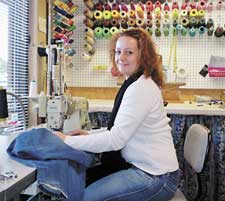JANUARY 5, 2011
Business to Business
The Horny Toad Restaurant & Bar after 35 years is still the BEST. Famous for their Fried Chicken. Also serving great tasting mouth watering Beef and Pork Ribs in a family atmosphere. Monday's all you can eat Beef Ribs. Friday's Fish Special all day long. Lunch and Dinner Sunday – Thursday 11 a.m. – 10 p.m., Friday – Saturday 11 a.m. – 11 p.m. 480-488-9542, 6738 E. Cave Creek Road. Check out their huge menu at www.thehornytoad.com.
Grand Opening!! Ground Control Hobby Corral and slot card raceways. Stop by 7100 E. Cave Creek Road, Suite 165 (Located in Stagecoach Village) and check out your modeling needs. Indoor Slot Raceway, Radio Control and Celestron Telescopes. Numerous brand names we stock arriving daily. We are offering 15% off all non-sale items, which expires on Jan. 31, 2011. Call 480-575-4352.
Messinger Pinnacle Peak Mortuary and Chapel, decorated in a beautiful Santa Fe style, serves all faiths while offering full services in burial, cremation, shipping and advanced planning. Located at 8555 E. Pinnacle Peak Road. For more information call 480-502-3378 or e-mail [email protected].
Now open!! Troon Eyecare now serving Troon, North Scottsdale, Carefree and Cave Creek Communities. Dr. Quint Di Giacomo O.D. gives all his patients personalized services at reasonable rates. Call today at 480-419-7778 for appointment. Troon Eyecare is conveniently located behind Chase Bank at 10025 E. Dynamite Blvd., Suite B-115, Scottsdale.
State Farm Agent, Bill Mulliniks, urges you to call today for car and home insurance and start saving now. Call Bill at 480-488-2101 or e-mail him at [email protected]
The Village Apartments “in the heart of the village of Cave Creek” is currently offering great special move in rates. Please call now for more information at 480-488-2502.
Contact Sturling & Stark for all your design needs. Interiors, renovation, colorization, and space planning are some of their specialty areas. Receive successful and professional results. Visit www.sturlingandstark.com or call 480-414-3222.
BY WESLEY SWIFT | JANUARY 5, 2011
Marketers tactics to target children
In his report, “Kid Kustomers,” Eric Schlosser discovers the tactics marketers and manufacturers utilize to target children. Schlosser claims that since the 1980s when working parents spent less and less time with their kids, they felt it necessity to spend more money on them. Manufacturers took advantage and began to promote a kid-related appearance. They started by observing children of specific ages to discover their interests and habits, receiving much of their information from the Internet and kids’ clubs. This provided the marketers insights on how to improve their business plan to attract more children and create cradle-to-grave customers. Their strategies often resulted in clever mascots like a fast food clown, a talking Chihuahua and Joe Camel. Companies’ new and effective advertisements reached kids’ homes across the country with the accessibility of television.
Schlosser writes about how the Joe Camel cartoon character, a representative of Camel cigarettes, became a familiar figure to young children. He reports, “A 1991 study published in the Journal of the American Medical Association found nearly all American six-year-olds could identify Joe Camel, who was just as familiar to them as Mickey Mouse.” This research is a shocking example of how children are targeted by commercials and then view the product being sold as kid-friendly or tempting. In fact, at that time it was estimated 32.8 percent of all cigarettes illegally sold to minors were Camels.
Schlosser references a professor of marketing at Texas A&M University, James U. McNeal. In his book, Kids as Customers, McNeal addresses the seven major requesting styles and appeals of kids or what Schlosser calls “nagging tactics.” Schlosser explains all seven but stresses the demonstrative nag. He says, “Demonstrative nags are the most high-risk, often characterized by full-blown tantrums in public places, breath-holding, tears, a refusal to leave the store.” McNeal wrote Kids as Customers as a guide for marketers on how to create kid customers, and he is just one of the many people to do so. Beth Thompson and Anne Sutherland both co-authored Kidfluence: The Marketer’s Guide to Understanding and Reaching Generation Y- Kids, Tweens and Teens. Kidfluence discusses the persistent nag which is a constantly repeated plea. Children learn this method plays on a parent’s guilt, and marketers learn how to create products that convince kids to use this and other nagging methods.
By using research from a federal investigation, Schlosser discovers children’s inadequate privacy from marketers on the Internet. The information found on the Internet by marketers was used to improve their business tactics to attract more kids. Schlosser states, “A 1998 federal investigation of websites aimed at children found that 89 percent requested personal information from kids; only 1 percent required that children obtain parental approval before supplying the information.” That year the Children’s Online Privacy Act of 1998 (COPPA) was created and required a website operator must include a privacy policy that insists on the consent of a parent or guardian to protect kids’ privacy online. However, the restrictions only applied to children under the age of 13.
Schlosser explains how children perceive television commercials. He writes, “Many studies had found young children often could not tell the difference between television programming and television advertising.” All children view approximately 50,000 television commercials yearly and are exposed to ads outside of the home on a daily basis. A report from 2000 by the Federal Trade Commission (FTC) stated that 44 films rated “Restricted” were targeted to children under 17. The commercials for these films aired on TV during the times when most young viewers were watching. The study also found 70 percent of video games rated “Mature” were targeted towards children under 17.
According to Media Awareness Network, industry spending on advertising to children has exploded in a decade. It has increased from $100 million in 1990 to more than $2 billion in 2000. In 2010 $10 billion dollars was spent on fast food advertising to children alone.

